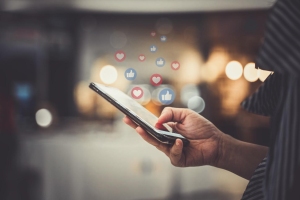 A study published in the National Institutes of Health’s National Library of Medicine found a correlation between the use of social media and eating disorders in young adults living in the United States. The DSM-5 definitions indicate that up to 2.6 percent of the population will need bulimia nervosa recovery by the time they reach 20 years of age. This research showed a strong and repeated relationship between eating disorders and social media in a sample of about 1800 adults aged 19 to 25.
A study published in the National Institutes of Health’s National Library of Medicine found a correlation between the use of social media and eating disorders in young adults living in the United States. The DSM-5 definitions indicate that up to 2.6 percent of the population will need bulimia nervosa recovery by the time they reach 20 years of age. This research showed a strong and repeated relationship between eating disorders and social media in a sample of about 1800 adults aged 19 to 25.
For this reason, any bulimia nervosa treatment center has to take the ubiquity of social media into account. In cases where self-image is impaired and comparisons against peers and celebrities are frequently made, social media can be a strong triggering factor in the rise of bulimia nervosa and other eating disorders.
Bulimia Nervosa Signs and Symptoms
Before any discussion about bulimia nervosa treatment, it’s important to outline the signs and symptoms of bulimia nervosa. In some situations, people might be confused about the difference between bulimia nervosa and anorexia nervosa. Bulimia nervosa signs and symptoms may appear in other types of disorders, but they are consistent and clear when compared to the DSM-5’s list.
For an eating disorder to be classified as bulimia nervosa, the DSM-5 defines certain criteria. First would be repeated and regular binge eating episodes, such as eating a significant amount of food in a short period, usually in secret. This is coupled with a lack of control concerning being able to stop or control how much or what is being eaten.
Binge eating episodes are followed by purging. Purging methods, such as extended fasting after a binge eating episode, self-induced vomiting, excessive or compulsive exercise or the misuse of diuretics, laxatives and the like, are used as a way to offset potential weight gain or caloric intake. These behaviors must occur at least once a week for three months, on average. Importantly as relates to social media, people with bulimia usually have body image distortions, thinking they are fat or that other people see them as fat.
Other signs of bulimia nervosa can be the presence of compulsive dieting, an obsession with weight loss and the controlled intake of food. Evidence indicating purging and binge eating episodes, like the odor of vomit or frequent trips to the bathroom after meals, food wrappers being hidden food, or boxes of diuretics and/or laxatives — also indicates that an individual might be struggling with bulimia nervosa.
Bulimia Nervosa Treatment And Social Media
Social media’s impact on self-image and self-esteem, especially among young people, can hardly be overstated. While social media can certainly help people connect with new friends and old, it can also be a source of harassment, pressure, and bullying, as well as unrealistic depictions of others’ lifestyles and bodies. Through the use of social media, young people can reach out for support and make new connections.
The flip side of the positives of social media are the ways it has been used to bully young people into doing and feeling like they aren’t living up to society’s expectations of them. It’s even more dangerous than the traditional media in promoting a “thinness” narrative which can influence eating disorders because someone like an Instagram model can interact with the person being mediated.
The successful treatment of bulimia nervosa disorder is easiest to achieve when early intervention is made when bulimia nervosa symptoms appear so that a proper diagnosis and treatment plan can be begun. During this treatment, body image distortions, anxiety, depression or other co-occurring issues can also be addressed.
Carefully crafted and created solutions for bulimia nervosa recovery must be tailored to address each individual’s circumstances and treatment needs. While many young people count on social media to stay connected to their support systems, a psychologically gentle treatment plan that focuses on high-frequency individual therapy provides the foundation for a recovery that can withstand the inevitable bumps that life — and social media — can deliver.
Shift Frequency © 2019 – Educational material
